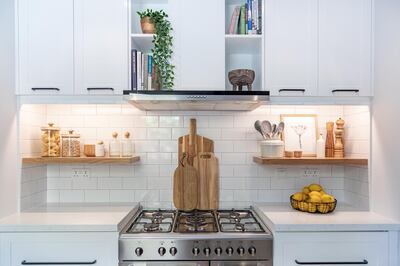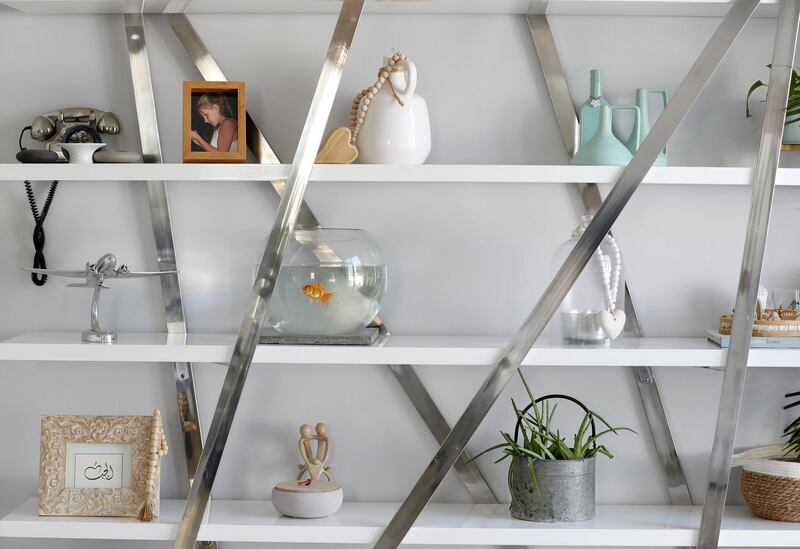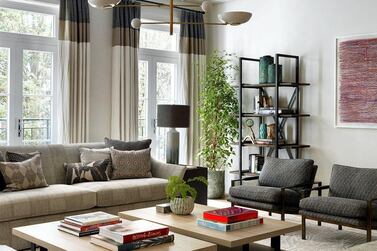Forget being self-obsessed: we’re now shelf-obsessed. The shift from selfie to shelfie may have started out as a clutter-clearing movement, but it’s also the perfect way to bring personality into the home through curating your favourite possessions artfully on shelves.
A shelfie can reveal a lot about you, including your passions, style and sense of imagination, and can include a photo of books arranged in colour or a snapshot of curios picked up on travels. Surrounding yourself with sentimental objects also brings back great memories, reminding you who and what is important. Consequently, these visual reminders can enhance your sense of happiness and well-being.
If you're not sure how to curate a hodgepodge of items into an artfully styled scene, then help is at hand from two UAE experts: interior designer Ruth Abela of design company Setting the Scene and interior stylist Lilly Engelbrecht, who runs home-styling service Escape Home Interiors.
Choose your backdrop
Start the shelfie-setting process by considering practical requirements and pieces you already possess. "If you're looking for something decorative, you could go for floating shelves," says Engelbrecht. "If it's functional and you need additional storage, a bookcase that has extra space below it does the trick. However, floating shelves also offer space underneath for storage baskets or an area to tuck away additional seating arrangements, such as stools. If you rent, it's always good to buy a freestanding bookcase that you can move on to the next home."
Abela adds: “Narrow floating shelves work well in a small nook, while doors maximise your storage space. Wallpaper, meanwhile, offers a great focal point to the room and colour to the back of your shelves.”
Consider who will be using the space, too. “If you have young children, then the best option might be a bookcase with a door, so little fingers can’t pull your beloved Kelly Hoppen books from the shelves quite as easily as they could with floating shelves.”
Book your place
Once you've cleared your shelf, it's time to get creative. "Books can give a solid base," says Engelbrecht. "You can place them horizontally – and stack things, such as candles on them – or vertically. With either choice, consider arranging the same width of books together or in size – from large to small." An option is to vary the look by having some books arranged horizontally and some vertically, adds Abela. "I cluster books of a certain genre together and then break them up with a knick-knack. Also, use bookends – they don't even have to be holding books together, but they look great on every shelf. Another interesting way of styling your bookshelves is to turn all of your books around so all you can see are the pages, offering the same tone throughout."
Colour is a fun element to play with, says Engelbrecht. "Remove the jacket cover because the book underneath is usually a neutral colour. Or you can style your books by block colour; in an ombre style, from dark to light; or in colour groups and working through the rainbow."
Get personal
Want to add character to a shelf? "Include a reminder of a great experience," says Abela. "Whether it's an item you've collected from an amazing holiday in Bali, a mask from Sri Lanka or a vase you made yourself in a pottery course." Artworks and photographs are other ways to add a personal touch. "Think of your kid's line drawing or Picasso-inspired piece," suggests Engelbrecht. "Or group some framed photos in the living, bedroom or communal areas. Avoid areas prone to steam, such as kitchens and bathrooms – plus, you probably don't want a face staring at you while you shower."

Groups and proportions
“While there aren’t any rules when it comes to playing with colour, it’s the way you group your items that’s important,” says Engelbrecht. “A single decor piece will get lost in the space, so it’s nice to start in the centre, and then group and style around it. I like to group things in threes.”
Getting the proportions right is key. “It looks bad if something is wedged into the shelf – make sure there’s enough head space for every item. Ensure there is enough height variation and don’t overstyle it.”
Abela adds: “Try to make the top shelf a bit smaller. That space can offer a good place to keep your paperbacks, give some uniformity at eye level and allow your eyes to wander to the rest of the shelves.”
Finally, make functionality a priority. Engelbrecht says: “Combine practical things with a few decor pieces, bearing in mind the location. In the kitchen, you can stack plates or glasses on shelves and fill pots, jugs or vases with wooden spoons. In the bathroom, little baskets with hand towels, glass jars with little perfumes in them or candles are always lovely. A pop of greenery, meanwhile, brings life to any shelf, while beautifully packaged candles are both decorative and functional.”
Abela adds: “I try to keep the display items relevant to that area.” For example, she suggests leaving a beautiful silver juice press or a coffee grinder resting on your latest Gordon Ramsay cookery book, for kitchen shelves.
Say cheese
There’s another reason for snapping your shelves: a camera often picks up what the naked eye misses. “Just stepping back and taking a picture of your work ensures the proportions and balance is right, and that it all makes sense,” says Engelbrecht.
You can also capture different looks easily by changing up a shelfie as often as you like. Simply changing the colours on the shelf can transform the entire look of a room.
“Have fun,” concludes Abela. “Interior design and styling is all about getting creative.”






